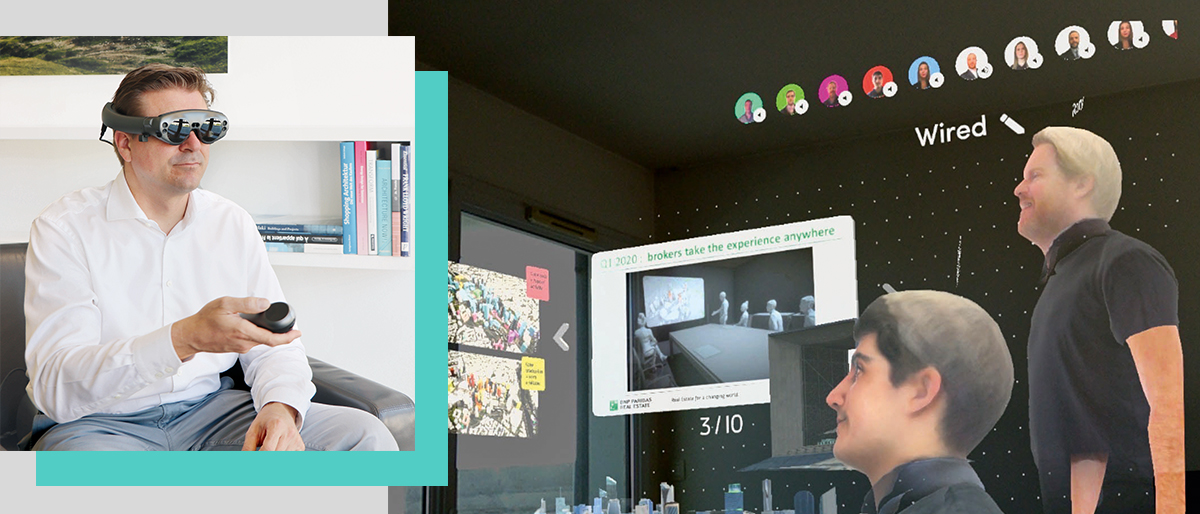HOLOMEETINGS – THE NEW DIMENSION IN COMMUNICATION
Technologies originating from the field of gaming which serve to enhance reality or create a user’s own virtual reality have since entered into use in the business world too. Virtual meetings employing mixed reality technology represent one of the latest trends.
Most of us have been using web conferences and video calls on a regular basis ever since the coronavirus pandemic broke out and working from home became broadly accepted practice. Apart from sharing one’s screen, this technology offers little further scope for interaction, however. Web conferences employing mixed reality technology are a quite different proposition. Here, each participant is represented by a virtual avatar. After creating their own individual avatars, people can meet up with other virtually represented participants in a meeting room for discussions. This creates a feeling as if all the participants were physically present. First and foremost, mixed reality conferences offer a means of jointly viewing and working on 3D objects. This means that customers and consultants can view buildings and their surroundings in a lifelike scenario. Digital information such as graphics or a PowerPoint presentation can also be virtually embedded in the real-life environment. An entire real-life meeting room can serve as a possible presentation space in mixed reality, for example.
HOW DOES MIXED REALITY DIFFER FROM OTHER VIRTUAL TECHNOLOGIES?
Mixed reality involves combining reality with artificial, computer-generated 2D or 3D objects. While in virtual reality the user finds themself in an entirely artificial world, augmented reality projects virtual content into reality. With mixed reality, objects from the real and virtual worlds are able to interact with one another. The technical requirements for such a meeting are perfectly manageable: All that is needed is a state-of-the-art pair of mixed reality goggles, such as Magic Leap One, and online access to the meeting platform. This is all it takes to transform a real-life workplace into a 3D workspace.
Best Practice
Holomeetings at BNP Paribas Real Estate
BNP Paribas Real Estate began experimenting with the new technology two years ago. In practice, it quickly lived up to our theoretical expectations: The hologram technology enabled us to present property investment opportunities to customers and investors in lifelike reality and in real time at their international locations, without any need to travel. Holomeetings have since been in regular use at the five offices in Dubai, Frankfurt, Hong Kong, London and Paris for internal and customer meetings.
"Holomeetings arouse great interest in talks with our partners."
In the Frankfurt team, Alexander Jostes, Head of Sales Wholesale at BNP Paribas Real Estate Investment Management, was involved in overseeing the new technology and its possibilities from the outset, and employed it in the market launch of the new open-ended real estate fund BNP Paribas MacStone. “Holomeetings arouse great interest in talks with our partners,” he observes. In the mixed reality environment, Alexander Jostes and his team were able to provide a vivid presentation of the investment concept for the new fund, which invests in future trends.

WHAT HARDWARE AND SOFTWARE DO HOLOMEETINGS REQUIRE?
Magic Leap One
Magic Leap One is a pair of wearable mixed reality goggles which use various sensors to detect and “read” the spatial environment and project appropriate virtual content relating to surfaces and furniture. The computer-generated objects are processed by means of a high-performance mini-computer which the user wearing the goggles has to carry with them.
Spatial
Spatial is a cutting-edge collaboration platform with a focus on reality-enhancing devices. VR / AR headsets and Magic Leap One can be used to turn a real-life workplace into a virtual monitor, enabling the user to interact with digital content and objects together with colleagues and customers.

